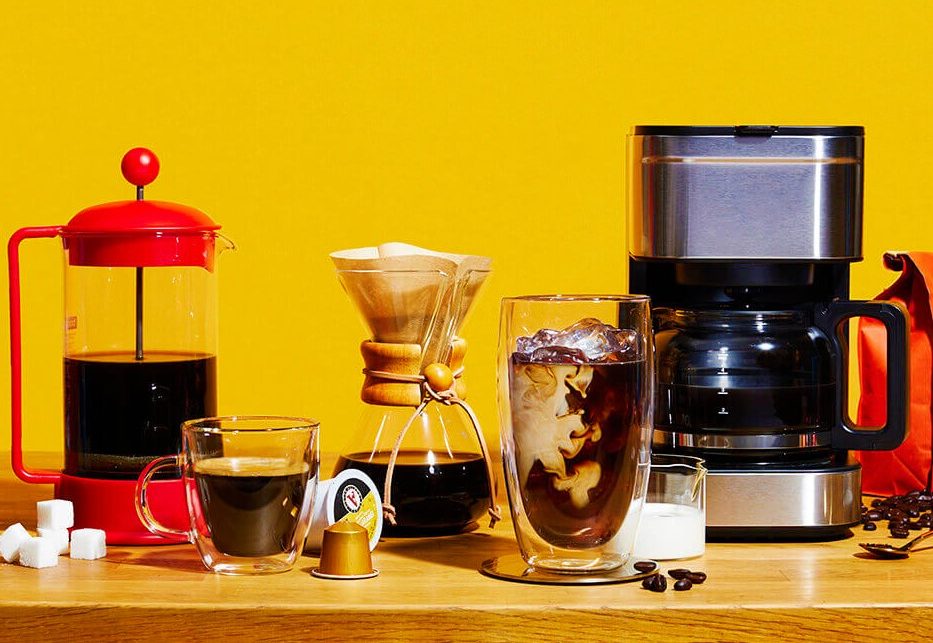How to Brew the Perfect Cup of Coffee: In a world that moves at an accelerating pace, a ritual remains timeless, grounding us amidst the chaos – the art of brewing the perfect cup of coffee. Beyond a mere morning pick-me-up, coffee is a symphony of flavors, aromas, and sensations that can elevate the ordinary to the extraordinary. Whether you’re a seasoned coffee connoisseur or a curious beginner, mastering the art of coffee brewing is an exploration into the nuances of taste, the science of extraction, and the satisfaction of creating a cup that resonates with your unique palate.
This article is your comprehensive guide to unlocking the secrets behind a flawless cup of coffee. From selecting the finest beans to mastering the intricacies of brewing methods, we will delve into the factors contributing to that elusive perfect cup. Join us on a caffeinated adventure as we navigate the terrain of coffee beans, grind sizes, water temperatures, and brewing equipment, all to transform your daily coffee routine into a ritual that awakens your senses and invigorates your spirit.
Whether you savor the simplicity of a classic black coffee or revel in the artistry of a meticulously crafted pour-over, the journey to perfection starts with understanding the fundamentals. So, grab your favorite mug, prepare to grind, measure, and brew, and let’s embark on a quest to beverage the perfect cup of coffee – a cup that transcends mere beverage status to become a moment of pure indulgence.
How to Brew the Perfect Cup of Coffee?

Here’s how to beverage the perfect cup of coffee at any time of day in 9 simple steps.
1. Find the Right Roast for You

The world of coffee is a rich tapestry woven with diverse flavors, and at the heart of this spectrum lies the crucial decision of selecting the proper roast. From the bright acidity of light roasts to the robust, smoky undertones of dark roasts, the degree to which coffee beans are roasted profoundly influences the taste, aroma, and overall experience of your cup.
With their crisp acidity and pronounced fruit or floral notes, light roasts offer a vibrant and nuanced flavor profile. These roasts showcase the distinct characteristics of the coffee bean’s origin, making them an excellent choice for those who appreciate the subtle intricacies of regional varietals. On the other end of the spectrum, dark roasts, characterized by their deep, rich body and bold flavors, appeal to those who seek a more intense, bittersweet experience.
Medium roasts balance the bright acidity of light roasts and the full-bodied richness of dark roasts. This versatile category often brings a harmonious combination of acidity and depth, making it a favorite among many coffee enthusiasts.
To discover the perfect roast for you, consider your taste preferences. A light roast might be your ideal companion if you enjoy the bright, lively notes of citrus or berries. Alternatively, a dark roast could be the key to your coffee satisfaction if you crave the smoky, caramelized tones with a hint of bitterness.
As you embark on your quest for the perfect cup, remember that the journey is as diverse as the beans. Experiment with different roasts, explore regional variations and let your taste buds be your guide. The proper roast is not a one-size-fits-all equation; it’s a personal discovery that transforms your coffee ritual into a tailored experience, ensuring each cup perfectly reflects your unique palate.
2. Get the Right Water Quality and Temperature

In crafting the perfect cup of coffee, the significance of water quality and temperature cannot be overstated. Coffee, after all, is more than just the sum of its beans; it is a delicate alchemy that requires the right conditions to reveal its authentic flavors and aromas. Join us as we delve into the essential considerations of water, exploring how its quality and temperature can elevate your coffee experience to new heights.
Water Quality:
Imagine a symphony where each instrument plays a crucial role in creating a harmonious melody. Similarly, water quality acts as the conductor in the coffee brewing orchestra. The minerals, impurities, and overall composition of the water used profoundly influences the taste of your coffee. Ideally, your water should be clean, free from strong odors or flavors, and have a balanced mineral content.
Filtered water is often recommended, as it removes impurities that can interfere with the nuanced flavors of your coffee. However, some minerals, such as magnesium and calcium, are essential for extracting the full spectrum of coffee flavors. Striking the right balance is essential – aim for water that complements, rather than overwhelms, the natural character of your chosen beans.
Water Temperature:
Temperature is the conductor’s wand, directing the pace at which flavors unfold during brewing. The ideal water temperature for coffee removal is generally between 195°F to 205°F (90°C to 96°C). Too hot, and you risk extracting bitter compounds; too cold, and the flavors may be underdeveloped.
Investing in a reliable thermometer or a kettle with temperature control is a small but impactful step toward precision in your brewing routine. When water hits the sweet spot temperature, it interacts with the coffee grounds to coax the optimal balance of acids, sugars, and oils.
As you embark on the quest for the perfect cup, pay attention to water quality and temperature details. Just as a virtuoso musician refines their instrument, honing these elements in your brewing process will refine the symphony of flavors in your coffee. With each sip, let the orchestrated dance of water and heat transport you to a world where every nuance is savored and every cup is a masterpiece.
3. Grind Your Beans

In pursuing the perfect cup of coffee, a transformative step stands between ordinary and extraordinary: grinding your beans. Just as an artist selects the finest brushes to create a masterpiece, choosing the right grind for your coffee is a meticulous process that significantly influences your brew’s flavor, aroma, and overall satisfaction.
Join us on a journey into the world of coffee grinders and discover how grinding your beans can be the key to unlocking a symphony of flavors in every cup.
Freshness Unleashed:
The moment coffee beans are ground, a clock begins to tick. The volatile compounds that give coffee its rich aroma and nuanced flavor start to dissipate, leaving behind a mere echo of what could have been.
By grinding your beans just before brewing, you ensure that each cup celebrates freshness. The aroma that wafts through the air as you grind is a prelude to the sensory delight awaiting you in the finished brew.
Grind Size Matters:
Much like a tailor meticulously measures fabric for the perfect fit, the grind size of your coffee beans must be tailored to your chosen brewing method. Different methods, whether a French press, espresso machine, pour-over, or drip coffee maker, demand specific grind sizes for optimal extraction.
For instance, a coarse grind suits the immersive steeping process of a French press, while a fine grind is imperative for the quick extraction of an espresso shot. The right grind size ensures that water interacts with the coffee grounds in a way that extracts flavors harmoniously without over-extraction bitterness or under-extraction sourness.
Invest in the Right Grinder:
Investing in a quality grinder is a paramount decision to embark on the journey of grinding your own beans. Blade grinders, while affordable, can result in uneven grounds that compromise flavor consistency. Burr grinders, on the other hand, offer precision by grinding beans uniformly, allowing for a more controlled extraction process. Your grinder becomes a tool and a companion on your quest for the perfect cup.
In coffee, grinding your beans is a ritual that bridges the gap between routine and reverence. With each turn of the grinder, you’re not just preparing coffee but crafting an experience. So, let the scent of freshly ground beans be the prelude to your daily coffee symphony, where every cup is a testament to the art and science of grinding your beans.
4. Gather and Invest in Good Tools

To embark on the journey of brewing the perfect cup of coffee, one must recognize that the right tools can be as transformative as the quality of the beans. Here, we delve into three indispensable tools that stand as pillars in the pursuit of coffee perfection: Burr Grinders, High-Quality Whole Coffee Beans, and Water Filters.
1. Burr Grinders: Precision in Every Grind
If grinding your beans is a pivotal step in your coffee ritual, then a Burr Grinder is the artisan’s tool of choice. Unlike blade grinders, which can result in uneven grounds, burr grinders ensure a consistent grind size, which is crucial for extracting balanced flavors. The precision offered by burr grinders allows you to tailor your grind to the specific requirements of your chosen brewing method, unlocking the full potential of your coffee beans.
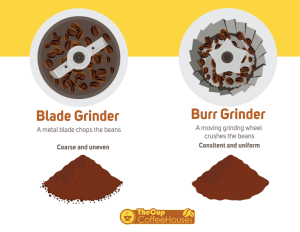
Investing in a high-quality burr grinder is an investment in the art of precision and the assurance that each cup is a testament to the meticulous craft of coffee brewing.
2. High-Quality Whole Coffee Beans: The Heartbeat of Flavor

The soul of a perfect cup of coffee lies in the beans themselves. Opting for high-quality whole coffee beans is a foundational choice that resonates through every step of the brewing process. Seek out freshly roasted beans, as this ensures the preservation of volatile compounds that contribute to the rich aroma and nuanced flavors.
The origin and roast level of the beans also performance a vital role in shaping the character of your brew. When you invest in premium, whole coffee beans, you’re not just purchasing a product; you’re acquiring the critical ingredient for a daily ritual that delights the senses.
3. Water Filter: The Unsung Hero of Purity
Water, the primary medium of your brew, can elevate or hinder your coffee’s flavors. Investing in a water filter is an often-overlooked but crucial step in pursuing coffee perfection. Filters remove impurities and balance mineral content, ensuring that the water complements, rather than masks, the inherent qualities of your chosen beans.
Just as a painter selects the purest pigments for their canvas, a water filter ensures that your brewing canvas is clean and untainted, allowing the true colors of your coffee to shine through.
In the symphony of coffee brewing, these tools—Burr Grinders, High-Quality Whole Coffee Beans, and Water Filters—stand as virtuosos, each playing a distinct role in orchestrating the perfect cup. As you gather and invest in these essential tools, you’re not just assembling equipment; you’re assembling the ensemble that will bring your coffee masterpiece to life.
5. Weigh Your Coffee—And Water
In the pursuit of brewing the perfect cup of coffee, precision is paramount. Just as a chef meticulously measures ingredients to ensure a flawless dish, the art of coffee brewing demands accuracy, particularly regarding the amount of coffee and water used.
Here, we explore why weighing both your coffee and water is a game-changer, offering not just consistency but also the ability to tailor your brew to perfection.
1. Consistency is King:
Imagine your favorite song played with slightly different instruments each time – the experience would vary, and the magic might be lost. Similarly, the consistency of your coffee grounds and water measurements is key to replicating the flavor profile you love. Weighing your coffee ensures that each brew is a faithful rendition of the last, providing a dependable baseline for your preferred taste.
2. Precision in Extraction:
Coffee brewing is a delicate dance between water and coffee grounds, and the ratio of these elements determines the harmony of flavors in your cup. Weighing coffee and water lets you maintain the ideal ratio for your chosen brewing method, preventing over- or under-extraction.
Too much coffee can produce a bitter brew, while too little may yield a weak, underwhelming cup. Precision in measurement ensures that your coffee sings with a balanced flavor symphony.
3. Tailoring to Taste:
Coffee preferences are as diverse as the beans themselves, and weighing your coffee and water empowers you to tailor your brew to your unique taste. Whether you prefer a bold, robust cup or a more delicate, nuanced flavor, precise measurements provide the control to achieve your desired results. It’s a personalized approach that transforms your daily cup into a reflection of your palate.
4. Brewing Consistency Across Methods:
Different brewing methods require specific coffee-to-water ratios to shine. Weighing your ingredients allows you to adapt to various techniques seamlessly, ensuring that your favorite coffee tastes just as exceptional, whether brewed through a pour-over, French press, or espresso machine. Consistent measurements offer flexibility in your brewing routine without compromising on quality.
As you begin weighing your coffee and water, envision yourself as a conductor orchestrating the perfect brew. Each gram measured is a note in the composition, contributing to a masterpiece tantalizing the taste buds. In the realm of coffee perfection, precision is not a mere suggestion – it’s the secret ingredient that turns a routine cup into a symphony of flavors.
6. Take the Water’s Temperature

In crafting the perfect cup of coffee, every detail matters, and water temperature is a pivotal factor that can make or break the brew. Much like a chef carefully controls the heat to achieve culinary excellence, monitoring the water’s temperature in coffee preparation is a practice that elevates the experience from ordinary to extraordinary.
Here’s why taking the water’s temperature is a crucial step in the pursuit of brewing nirvana.
1. Unlocking Flavor Chemistry:
Coffee grounds hold a treasure trove of flavors, each waiting to be coaxed out by the magic touch of hot water. However, the temperature of that water is the alchemist’s wand, determining the speed and efficiency of flavor extraction.
The optimal range for water temperature in coffee brewing is generally between 195°F to 205°F (90°C to 96°C). This sweet spot allows for the extraction of desirable compounds while avoiding the bitterness associated with over-extraction or the underdeveloped flavors of under-extraction.
2. Precision in Extraction:
Different compounds within coffee beans dissolve at varying temperatures. Caffeine, for example, dissolves relatively quickly, while the more complex flavors develop at a slightly lower temperature.
Monitoring and controlling the water temperature gives the brewer the precision needed to strike the right balance, resulting in a cup embodying the full spectrum of flavors within the coffee grounds.
3. Consistency Across Brews:
Just as a symphony relies on a consistent tempo, maintaining a consistent water temperature ensures that each cup of coffee is a harmonious rendition of your preferred flavor profile. Investing in a reliable thermometer or a kettle with temperature control allows you to recreate the same delightful experience with every brew, avoiding the frustration of unpredictable results.
4. Adapting to Brewing Methods:
Various brewing methods, from French press to pour-over, may require slight adjustments in water temperature to achieve optimal results. For instance, a lower temperature might be suitable for delicate pour-over methods, while a slightly higher temperature could enhance the richness of espresso brewing. Customizing water temperature based on the brewing method ensures that each cup is tailored to the specific needs of the process.
As you embark on the journey to brew the perfect cup of coffee, consider the water temperature as the conductor’s baton, guiding the symphony of flavors to create a sensory masterpiece. With each carefully measured degree, you’re not just making coffee; you’re orchestrating an experience that tantalizes the taste buds and transports you to the realm of coffee perfection.
7. Time It

Timing in coffee brewing is crucial for achieving the perfect cup. The duration of water contact with coffee grounds determines flavor extraction. Short times risk under-extraction (sourness), while long times lead to over-extraction (bitterness). Consistent timing ensures replicable results and adapts to different coffee varieties and brewing methods. Mastery of timing is the rhythm that orchestrates the symphony of flavors, turning each cup into a harmonious experience.
8. Pick Your Brew Method

Pick Your Brew Method: A Comprehensive Guide to Different Brewing Techniques
Aeropress:
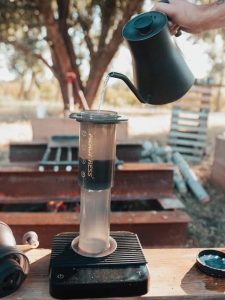
- Definition: The Aeropress is a portable, manual preparing device that uses air pressure to force warm water through coffee grounds.
Making Method:
-
- Assemble Aeropress components.
- Add finely ground coffee to the brewing chamber.
- Pour warm water over the coffee.
- Attach the plunger and let it steep.
- Press the plunger slowly to extract the coffee.
- Dilute with hot water if desired.
- Stir and serve.
- Cleanup by ejecting the coffee puck and rinsing.
- Enjoy a versatile and flavorful cup.
2. Chemex:

- Definition: The Chemex is a pour-over coffee maker known for its hourglass shape and thick paper filters, resulting in a clean and bright cup.
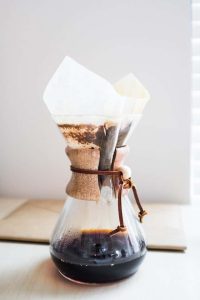
Making Method:
-
- Insert a Chemex filter and rinse with hot water.
- Add medium-coarse coffee grounds to the filter.
- Bloom the grounds with a small amount of hot water.
- Pour the water in a circular motion.
- Adjust the pour rate for the desired extraction time.
- Remove the filter, and serve the coffee.
- Appreciate the clarity and complexity of flavors.
- Dispose of the filter and grounds.
- Enjoy a refined and balanced cup.
3. French Press:
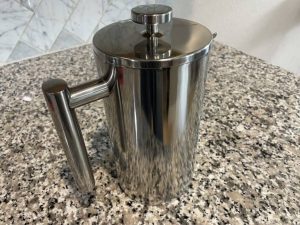
- Definition: The French Press, or press pot, is a manual brewing device that immerses coffee grounds in hot water and separates them using a plunger.
Making Method:
-
- Coarsely grind coffee beans.
- Add coffee grounds to the French press.
- Pour hot water over the grounds.
- Mixing and place the lid on the French press.
- Let it steep for 4 minutes.
- Slowly press the plunger down.
- Pour into your cup.
- Savor the rich and full-bodied flavors.
- Clean by separating the plunger and rinsing components.
4. Espresso:

- Definition: Espresso is a concentrated coffee prepared by forcing warm water through finely ground coffee under high pressure.
Making Method:
-
- Measure and grind coffee finely.
- Preheat the espresso machine.
- Tamp the coffee grounds into the portafilter.
- Attach the portafilter to the machine.
- Start the shot, aiming for 25-30 seconds.
- Adjust grind size, dose, and time for taste.
- Pour the espresso shot into a demitasse cup.
- Sip slowly and appreciate the intensity.
- Clean by emptying the portafilter and wiping surfaces.
5. Auto-Drip:
- Definition: Auto-Drip refers to coffee makers that automate the brewing process, allowing water to drip through coffee grounds and filters.
Making Method:
-
- Measure coffee according to machine recommendations.
- Add water to the machine’s reservoir.
- Place a filter and add measured coffee grounds.
- Start the machine to initiate brewing.
- Allow the machine to complete the cycle.
- Pour the brewed coffee into your cup.
- Customize strength with grind sizes and ratios.
- Enjoy a convenient cup of coffee.
- Clean by discarding the used filter and grounds.
9. Descale And Clean Your Coffee Maker Regularly

Just as a chef diligently cleans their kitchen to ensure the purity of their creations, coffee enthusiast must treat their coffee maker with the same care and attention. Descaling and cleaning your coffee maker is not just a matter of hygiene; it’s a crucial step in preserving the integrity of your brew and extending the life of your equipment. Here’s why this routine maintenance is paramount in pursuing the perfect cup.
- Scale Buildup and Mineral Deposits: Over time, minerals from water, such as calcium and magnesium, can accumulate in your coffee maker, forming scale deposits. These deposits touch the taste of your coffee by interfering with the extraction process and impeding the machine’s efficiency. Descaling removes these mineral deposits, allowing your coffee maker to function optimally.
- Flavor Purity: A clean coffee maker ensures that the flavors of your coffee remain untainted. Residual oils and coffee residues can build up, creating a rancid taste and altering the aroma of your brew. Regular cleaning prevents these residues from compromising the purity of your coffee, allowing you to savor the full, unadulterated spectrum of flavors.
- Equipment Longevity: Consider your coffee maker a finely tuned instrument. Regular descaling and cleaning contribute to its longevity by preventing corrosion and wear caused by mineral deposits and grime. Just as a well-maintained car engine performs better and lasts longer, a clean coffee maker delivers consistent quality over time.
- Consistent Performance: A well-maintained coffee maker ensures consistent performance, cup after cup. When your machine operates at its best, you can rely on precise water temperature, even extraction, and a reliable brewing time. Consistency is the bedrock of a perfect cup, and regular maintenance ensures that every brew meets your expectations.
- Hygiene and Safety: Neglecting the cleanliness of your coffee maker can lead to the growth of mold, bacteria, and other undesirable microorganisms. Regular cleaning ensures a hygienic brewing environment and safeguards your health. It’s a simple yet effective way to enjoy your coffee with peace of mind.
In the quest for the perfect cup, consider the maintenance of your coffee maker as a ritual that honors the craftsmanship of brewing. By regularly descaling and cleaning, you preserve the quality of your equipment and uphold the integrity of your daily coffee experience.
Conclusion:
In the rich tapestry of coffee brewing, achieving the perfect cup is a harmonious blend of science and art. From carefully selecting high-quality beans to the precision of water temperature and the meticulousness of grinding, every step contributes to the symphony of flavors that dance within your cup.
As you embark on your daily ritual of crafting the perfect cup, remember that perfection is subjective and personal. The perfect cup of coffee is the one that brings joy to your senses, a cup that reflects your unique palate and the craftsmanship you invest in every step. Whether you’re savoring the brightness of a Chemex pour-over, the richness of a French press, or the boldness of an espresso shot, each cup is a testament to your dedication to brewing.
So, take a moment to relish the aroma, appreciate the nuanced flavors, and celebrate the ritual of coffee. The perfect cup is not a destination but a journey that unfolds with every grind, pour, and sip. May your coffee adventures continue, and may each cup be a delightful note in the symphony of your daily life. Cheers to the perfect cup of coffee, however, you define it!
FAQs:
Where do you find good coffee?
Here is the general information on where to find good coffee:
- Local Specialty Coffee Shops: Explore local coffee shops or cafes specializing in high-quality coffee. These establishments often source beans from reputable roasters and may offer a variety of brewing methods.
- Roasteries: Look for coffee roasteries in your area or online. These establishments focus on the roasting process and often provide detailed information about the origin of their beans. Some may even allow you to purchase freshly roasted beans directly.
- Farmers’ Markets: Visit your community’s farmers’ markets or artisanal markets. Local coffee vendors at these markets may offer unique and freshly roasted beans.
- Online Specialty Coffee Retailers: Numerous online platforms specialize in selling specialty coffee beans. These websites often provide information about the beans’ origin, flavor profile, and roasting process.
- Subscription Services: Consider subscribing to a coffee subscription service. These services regularly deliver freshly roasted beans to your doorstep, introducing you to different varieties and roasters.
- Coffee Festivals and Events: Attend coffee festivals or events in your area. These gatherings often feature local and international coffee roasters showcasing their best products.
- Ethnic Grocery Stores: Explore ethnic grocery stores, especially those catering to communities with a strong coffee culture. You may find unique coffee beans and traditional brewing methods.
- Local Coffee Associations: Check if your community has local coffee associations or clubs. Members may share recommendations and insights into where to find the best coffee.
- Reviews and Recommendations: Utilize online platforms, review websites, and social media to discover highly recommended coffee spots. Peer reviews and recommendations can be valuable in finding hidden gems.
Remember that “good” coffee is subjective, and preferences vary. Some prefer a light roast with fruity notes, while others enjoy a dark roast with chocolate undertones. Exploring different sources and trying various beans will help you discover what suits your taste preferences.
How important is fresh coffee?
Freshness is a crucial factor in determining the quality of coffee, and it significantly impacts the flavor, aroma, and overall enjoyment of the brew. Here’s why fresh coffee is essential:
- Flavor Preservation: Coffee beans contain volatile compounds contributing to their distinct flavor profile. Once roasted, these compounds degrade over time, leading to a loss of freshness. Freshly roasted coffee retains more flavorful compounds, producing a more vibrant and nuanced taste.
- Aroma Intensity: The aroma of coffee is a significant part of the overall sensory experience. Freshly ground coffee beans release a more potent and enticing aroma, adding to the pleasure of the brewing process and enhancing the anticipation of the forthcoming cup.
- Complexity of Flavors: Coffee is known for its diverse and complex flavor characteristics, ranging from fruity and floral to nutty and chocolatey. Fresh coffee allows you to experience the full spectrum of these flavors, providing a richer and more satisfying cup.
- Acidity and Brightness: In specialty coffee, acidity is a positive attribute contributing to the overall taste profile. Fresh coffee tends to exhibit a more pronounced acidity, which can enhance the brightness and liveliness of the cup.
- Optimal Extraction: Freshly ground coffee allows optimal extraction during brewing. Stale coffee may result in uneven extraction, leading to over-extraction or under-extraction and, consequently, a less balanced and enjoyable cup.
- Enjoyment and Ritual: For many coffee enthusiasts, brewing coffee is a daily ritual. Fresh coffee adds a layer of enjoyment to this ritual, creating a sensory experience beyond drinking the beverage.
- Health Benefits: While not directly related to flavor, it’s worth noting that coffee contains antioxidants, and fresher beans may retain more of these beneficial compounds. Some studies suggest that fresher coffee may have higher levels of specific bioactive compounds.
- Support for Local Roasters: Purchasing fresh coffee means supporting local roasters who take pride in their craft. These roasters are more likely to prioritize quality, sourcing beans from reputable sources and roasting in small batches to maintain freshness.
In summary, freshness is paramount in the world of coffee. Whether you’re brewing a simple cup at home or indulging in a specialty coffee experience, the quality of your beans and the freshness of your coffee will significantly influence the outcome. For those seeking the perfect cup, starting with fresh, high-quality coffee is a fundamental step.
How long will ground coffee stay fresh?
Various factors, including the type of coffee, the grind size, storage conditions, and the initial quality of the beans, influence the freshness of ground coffee. Here are some general guidelines on how long ground coffee will stay fresh:
- Whole Beans vs. Pre-Ground:
- Whole beans retain freshness longer than pre-ground coffee because their protective outer layer slows the oxidation process. Grinding exposes more surface area to air, accelerating flavor deterioration.
- Type of Coffee:
- Different coffee varieties have varying degrees of freshness. For instance, high-quality, freshly roasted beans will maintain their flavors better than lower-quality or older beans.
- Grind Size:
- Finely ground coffee has a larger surface area exposed to air, making it prone to quicker flavor degradation than coarsely ground coffee. Espresso grind, for instance, loses freshness faster than a coarse French press grind.
- Storage Conditions:
- Proper storage is crucial for preserving freshness. Ground coffee should be stored in an airtight ampule, away from light, heat, and moisture. Avoid keeping it in the refrigerator or freezer, as moisture can accumulate and compromise the flavor.
- Initial Quality of Beans:
- The freshness of coffee ultimately depends on how recently the beans were roasted. Freshly roasted beans will produce more flavorful and aromatic coffee than beans sitting for an extended period.
- Time Frame:
- Generally, ground coffee is best consumed within two weeks to a month of grinding for optimal flavor. Beyond this period, it may still be safe to consume, but the flavors may have deteriorated.
- Packaging:
- Coffee packaging plays a role in maintaining freshness. Coffee bags with one-way valves allow carbon dioxide, released by freshly roasted coffee, to escape without letting air in. This helps in preserving flavor.
- Environmental Factors:
- Environmental situations, such as moisture and temperature, can affect the freshness of ground coffee. Storing it in a cool, dry place gone from direct sunlight will help extend its shelf life.
Remember that these are general guidelines, and the freshness can vary based on the mentioned factors. For the best coffee experience, purchasing whole beans, grinding them just before brewing, and storing them properly in an airtight container is recommended. Experimenting with different storage methods and observing the changes in flavor over time can help you find the optimal approach for your preferences.

